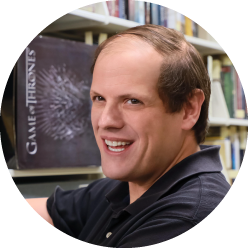Live to Build a Better World
By Shelby Hebert and Jeremy Brett | 04-26-2021

Science fiction is a genre defined by change. At its very heart, science fiction examines shifts in our social structures, environments, and selves. With the increasing threat of environmental disaster driven by climate change, climate fiction offers people the opportunity to explore potential futures for humanity and earth. Live to Build a Better World: Despair, Survival, and Hope in Science Fiction’s Response to Environmental Change is an exhibition that features works of fiction grappling with those futures.
The exhibition is split into eleven themes, describing many of the various threats posed by climate change and the ways in which humanity responds to those threats. Rising sea levels are of particular concern in coastal and low-elevation communities like Houston and New Orleans, so items from The Sea Takes Us may tell increasingly familiar tales. Similarly, increased levels of drought and more severe wildfires across the globe are mirrored in It’s Getting Hot in Here, which is full of tales of rising temperatures and the associated consequences. As the impacts of climate change become more severe, so does humanity’s response to it. Stories from Eco-Politics depict potential activism (including what some call ‘ecoterrorism’) and political actions taken to ensure human survival. And I'm Going To Have To Science The $%#& Out Of This presents different stories of ways in which people have turned their ingenuity towards solving the grave problems that climate change presents.
Items from the exhibition cover a wide range of climate-related topics. Just to take a few examples: Flight Behavior by Barbara Kingsolver (Cushing Library/Science Fiction/Call Number: PS3561.I496 F55 2012) explores questions about class and gender set against the backdrop of a rural Tennessee community discovering changes in Monarch butterfly migratory patterns, which are indicative of larger environmental problems. One theme of Kim Stanley Robinson’s New York 2140 (Cushing Library/Science Fiction/Call Number: PS3568.O2893 N49 2017) is humanity’s ability to resist true change even as the world around us becomes unrecognizable. The story follows a collection of New Yorkers, bonded together by the building they live in, and is set amongst the inescapable backdrop of a mostly underwater New York City. Characters include a Wall Street stock trader, a social media influencer, an immigration attorney, the building’s superintendent, and a pair of young boys trying to get rich quick. The book can be read with the somewhat fatalistic interpretation that humanity is incapable of true change, or the more hopeful reading that, despite overwhelming transformation, we are capable of retaining what it truly means to be human. Octavia Butler’s dystopian classic Parable of the Sower (Cushing Library/Science Fiction/Call Number: PS3552.U827 P37 1993) offers readers a grim, but ultimately hopeful tale set in a United States collapsing from political, social, and environmental upheavals. Lauren, the protagonist and a woman with heightened levels of empathy, creates a religion called Earthseed, dedicated to the central tenet that “God is change.” This new faith proves to be a hopeful constant in a tumultuous world. It reminds readers that not only is change inevitable, but we have the power to shape the ways in which both we and the world around us change.
Although most of the exhibition consists of books and periodicals, other forms of creative endeavor are also found here. One featured item is the movie poster for Pixar’s WALL-E (Cushing Library/Science Fiction/Call Number: PN1995.9.P5 W35 2008), a heartwarming tale of the last little trash compactor, left behind on a garbage-covered Earth. The film invites audiences to consider the repercussions of unchecked consumption and the importance of connection. Alongside works of fiction, curators chose to incorporate information about actual changes in the climate through other media, including knitted tapestries detailing temperature changes in College Station over the span of decades, and an event featuring guest speaker Dr. John Nielsen-Gammon, the Texas State Climatologist (April 1, 2021).
With the ever-increasing threat of climate change, we hope this exhibition inspires our patrons to create changes of their own, and to become invested in the well-being of the planet and of humanity. We hope patrons can find a way to see the dangers in our changing environments and feel a sense of hope rather than despair. Live to Build a Better World: Despair, Survival, and Hope in Science Fiction’s Response to Environmental Change is open January 19 – June 30, 2021. The exhibition can be enjoyed in person on Monday–Friday between 10:00 a.m.– 12:00 p.m. and 1:00 p.m.– 4:00 p.m.
Tags: Climate Change; Science Fiction; Climate Fiction.
Cushing Memorial Library and Archives Collections: Science Fiction & Fantasy Research Collection
Contact Us: cushingcollective@library.tamu.edu
|
Shelby Hebert is a Library Associate working with the map collections at Texas A&M University Libraries. She is interested in exploring the intersection of libraries and social justice movements and the ability of libraries to lift from the margins. She will graduate with her Master of Library and Information Science from San José State University in December 2021. |
|
 |
Jeremy Brett is an Associate Professor at Cushing Memorial Library & Archives, where he is both Processing Archivist and the Curator of the Science Fiction & Fantasy Research Collection. He has also worked at the University of Iowa, the University of Wisconsin-Milwaukee, the National Archives and Records Administration-Pacific Region, and the Wisconsin Historical Society. He received his MLS and his MA in History from the University of Maryland – College Park in 1999. His professional interests include science fiction, fan studies, and the intersection of libraries and social justice. |